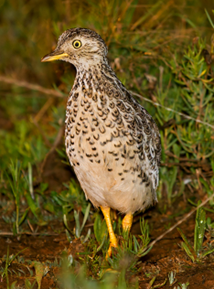
Listen up to everyone who’s felt helpless by the crushing enormity of habitat and species loss.
You can join like-minded folks offering hands-on help to protect Victoria’s critically endangered Plains-wanderer. You can help by eavesdropping on life on the grassy Northern plains from the comfort of your lounge room, any time of day or night.
It’s exciting to listen to the recordings and hear what a Plains-wanderer call sounds like
'I also liked to hear the other sounds of the Northern Plains Grassland (aside from the livestock, although amusing!),' she adds.
By looking at and listening to recordings collected by a network of more than 60 song meters, citizen scientists are helping to locate Plains wanderers in the wild. 'When we know where they are, we can protect and enhance their threatened native grassland habitat,” says project lead Dr Aaron Grinter.
The wonderful Wanderer
The mostly ground-dwelling Plains-wanderer stands about 20 centimetres tall. It could be described as quail-like but with longer legs and a skinnier body. The female has a white-spotted black collar and reddish-brown breastplate and is responsible for the calls recorded on the Song Meters. The smaller male incubates the eggs and rears the chicks.
Plains-wanderers are the last species of a genetic line that dates back more than 100 million years. They have no living relatives and are thus ranked the number one bird in the world for conservation importance by the London Zoological Society (EDGE ranking). Their closest relative is a South American inland shorebird. This suggests the Plains-wanderer is the last in an ancient lineage tracing back to when Australia was connected to Antarctica and South America, part of the Gondwana supercontinent.
The Plains-wanderer is also perfectly camouflaged in the expansive grassy plains. While this helps hide from predators, it makes it very tricky for surveying researchers to spot them.
How to find the hard-to-find bird
One of the tools surveyors use to overcome this is bioacoustic recorders, Song Meters. Placed in the field, song meters record twice daily, hoping to capture a Plains-wanderer call. This allows surveys across a greater area than possible in person using spotlights. Listening to recordings is also unobtrusive, with minimal birds or fragile grasslands disturbance.
'I enjoyed learning something new, the hands-on nature of the project, and that I could help with the surveying effort for a species that is not doing so well,” says Kyvelie.
Kyvelie is one of around 25 volunteers trained to use the analysis software and educated on the qualities of a Plains wanderer call.
Another volunteer, Jack, adds: 'Having an opportunity to contribute to the preservation of a critical species in such an important area was fantastic.”
DEECA is part of a collaborative effort involving government and non-government organisations and private landholders working together to reverse the population decline of Plains wanderers through habitat protection and expansion and a captive breeding program.
How you can help
The public is invited to get involved in the Plains-wanderer song meter program. After a short training session, people can access recordings online, look at or listen to recordings of potential Plains-wanderer calls, and confirm whether the call is really that of a Plains-wanderer. Volunteers can contribute as much or as little time as they like to the cause.
Volunteers are such an essential part of programs that help threatened species. People can learn valuable skills and protect the environment at the same time. Environmental programs would not be possible without citizen scientists.
Victoria is the most intensively settled and cleared state in Australia. The decline in the amount and quality of habitat has had major impacts on Victoria’s plants and animals. This is particularly true for Plains wanderers, who have lost approximately 99% of their habitat since colonisation. The plight of this species is urgent, as Victoria has already lost 18 species of mammal, two birds, one snake, three freshwater fish, six invertebrates and 51 plants since European settlement.
Today, between one-quarter and one-third of Victoria’s terrestrial plants, birds, reptiles, amphibians and mammals, and many invertebrates and ecological communities are at risk of extinction.
To help the Plains-wanderer, find more information about and sign up for the Plains-wanderer song meter program.
This project is supported by the Victorian Government’s Icon Species Biodiversity On-Ground Action initiative.
Page last updated: 25/11/24